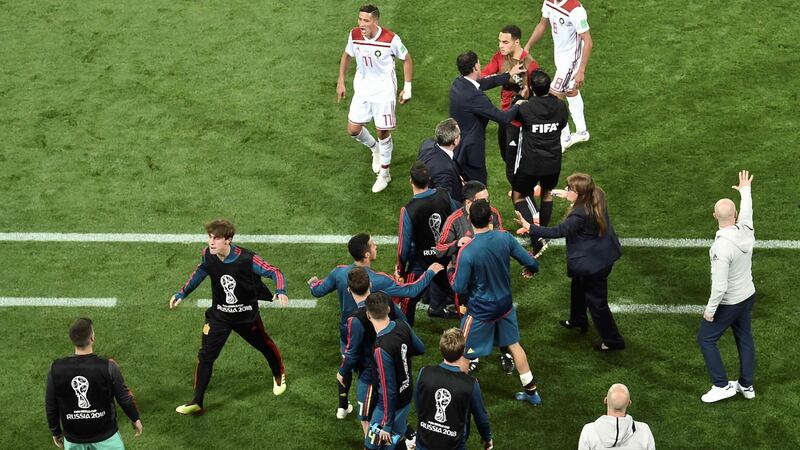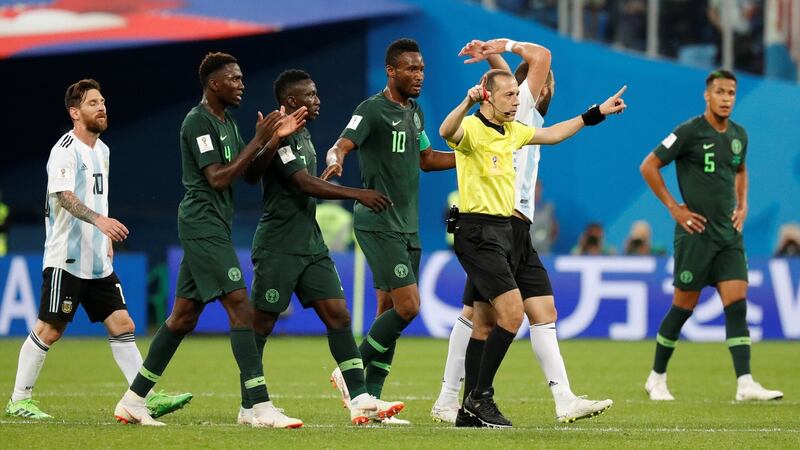So here we go again, another discussion about VAR. It feels like a day hasn't passed at this World Cup without the video-assistant elephant in the room raising its trunk and spraying controversy all over proceedings, and that is largely because a day has indeed not passed without its use – or lack of – becoming a matter for discussion.
Tensions have been simmering and reached boiling point after Monday’s double header in Group B. The outcomes of Iran’s 1-1 draw with Portugal in Saransk and Spain’s 2-2 draw with Morocco in Kaliningrad were both affected by the link-up between officials at the stadiums and those back at VAR HQ in Moscow. There were right calls, there were wrong calls, and by the end came the impression that something designed to reduce the sense of injustice and foul play in football has made matters worse.
Carlos Queiroz was sent into a rage by Enrique Cáceres’s handling of Iran versus Portugal, specifically the Paraguayan referee’s decision to not dismiss Cristiano Ronaldo for an off-the-ball swing of the elbow at Morteza Pouraliganji after a VAR review. Cáceres watched the replay in the review area and decided to show Ronaldo a yellow card. “It’s a red card [for the elbow]or it’s not a red card,” said Queiroz. “My daughter can’t come home and say I’m sort of a granddad; either she’s pregnant or she’s not.”
Iran’s manager, who temporarily stormed down the tunnel, was no doubt happier with Cáceres’s decision to award his team a penalty in the closing stages after a supposed handball by Cédric Soares was also reviewed. Again the referee consulted his screen and again he changed his mind; this time he was most definitely wrong. Karim Ansarifard converted the spot kick and it meant Portugal finished second and face a daunting last-16 tie against Uruguay.
Alan Shearer described the technology as a “farce” in his role as a BBC pundit. On Twitter the Liverpool midfielder James Milner called it an “absolute shambles”, adding the hashtag #beautifulgamespoilt.
Over in Kaliningrad, meanwhile, came the counter-argument as a VAR referral correctly awarded Spain a 90th-minute equaliser that led to them topping the group and facing Russia in the last 16. Iago Aspas’s close-range finish was initially ruled out for offside before three minutes of checking led to a change of heart by the Uzbek referee Ravshan Irmatov.

“VAR didn’t save us, it just told the truth,” said Sergio Ramos, which somewhat overlooked the fact his centre-back partner Gerard Piqué should have been sent-off in the first half for a two-footed, studs-up lunge on Khalid Boutaïb. The Morocco midfielder Nordin Amrabat made clear his feelings about the lack of intervention in regards to that incident, calling VAR “bullshit” as he looked down the lens of a television camera upon departing the pitch.
The game was goalless and could have turned out very differently had Spain been reduced to 10 men. But then again things would have been different had VAR not intervened with regard to Aspas’s goal, and at this point it feels important to again outline what VAR is for and how it works.
The team of four officials, located in a central operation room, have access to all 33 of the broadcast cameras inside the stadium (as well as two additional cameras dedicated to monitoring possible offsides) and their role is to check for “clear and obvious” errors as well as review footage upon the instruction of the referee. They make only factual game-changing decisions, such as offside, and review only goals, penalty decisions, direct red cards and cases of mistaken identity.
The guidelines are clear, then, and the issue at these finals is implementation. By the Guardian’s count there had been a little over 20 notable uses and non-uses of VAR by the end of Tuesday afternoon’s games and, of those, around 10 have led to a correct decision.
Goals
This is the area where VAR has been used best. There have been three incidents when a goal, upon being scored, has been checked via VAR and on each occasion the right decision was made: Diego Costa for Spain versus Portugal (given), Saeid Ezatolahi for Iran v Spain (ruled out), Aspas v Morocco (given).

Penalty decisions
The first use of VAR at this World Cup was centred on a penalty call – Josh Risdon’s tackle on Antoine Griezmann in Australia’s match against France. The Uruguayan official Andrés Cunha pointed to the spot having received word from Moscow and even after numerous replays it was hard to say whether he made the right call. Either way, it was not a clear and obvious error. From thereon, there have been correct decisions – Neymar against Costa Rica, the foul on Sweden’s Viktor Claesson versus South Korea, Mohamed Salah against Russia, Gylfi Sigurdsson versus Nigeria – as well as incorrect ones. Harry Kane should have been awarded a penalty against Tunisia as should have Ronaldo against Morocco and Aleksandar Mitrovic against Switzerland, while, as mentioned, Soares was incorrectly penalised against Iran. As with Risdon on Griezmann, there have also been calls that fall into a grey area – namely Denmark’s Yussuf Poulsen versus Australia and Ronaldo versus Iran.
Red cards
Decisions based on the disciplining of players has arguably been where VAR has performed worst. There were a couple of correct decisions to not issue red cards during the final, tetchy minutes of Serbia versus Costa Rica but after that it has all largely gone wrong. Ante Rebic should have been sent off for a studs-up, shin-high challenge on Eduardo Salvio during Croatia’s 3-0 victory over Argentina. And then there was the non-dismissal of Piqué on Monday.
Mistaken identity
A perfect score for VAR here, albeit there has been only one such incident. It came during France’s 1-0 victory over Peru when a word in Mohammed Abdulla Mohamed’s ear led to the UAE official correctly showing Pedro Aquino a yellow card.
Conclusion: clarity needed
VAR has had a mixed time in Russia, then, but that was always going to be the case given this is the first World Cup in which the system has been used. One helpful measure could be to take “clear and obvious” out of the wording of the regulations as this has undoubtedly muddied waters in terms of what those watching on in Moscow should and should not be looking out for. Another thing to consider would be to stop those such as Cáceres from officiating top-level matches again. The 44-year-old’s use of VAR on Monday exposed him as a weak-minded official, turning something designed to make his job easier into a tool for chaos. – Guardian service




















